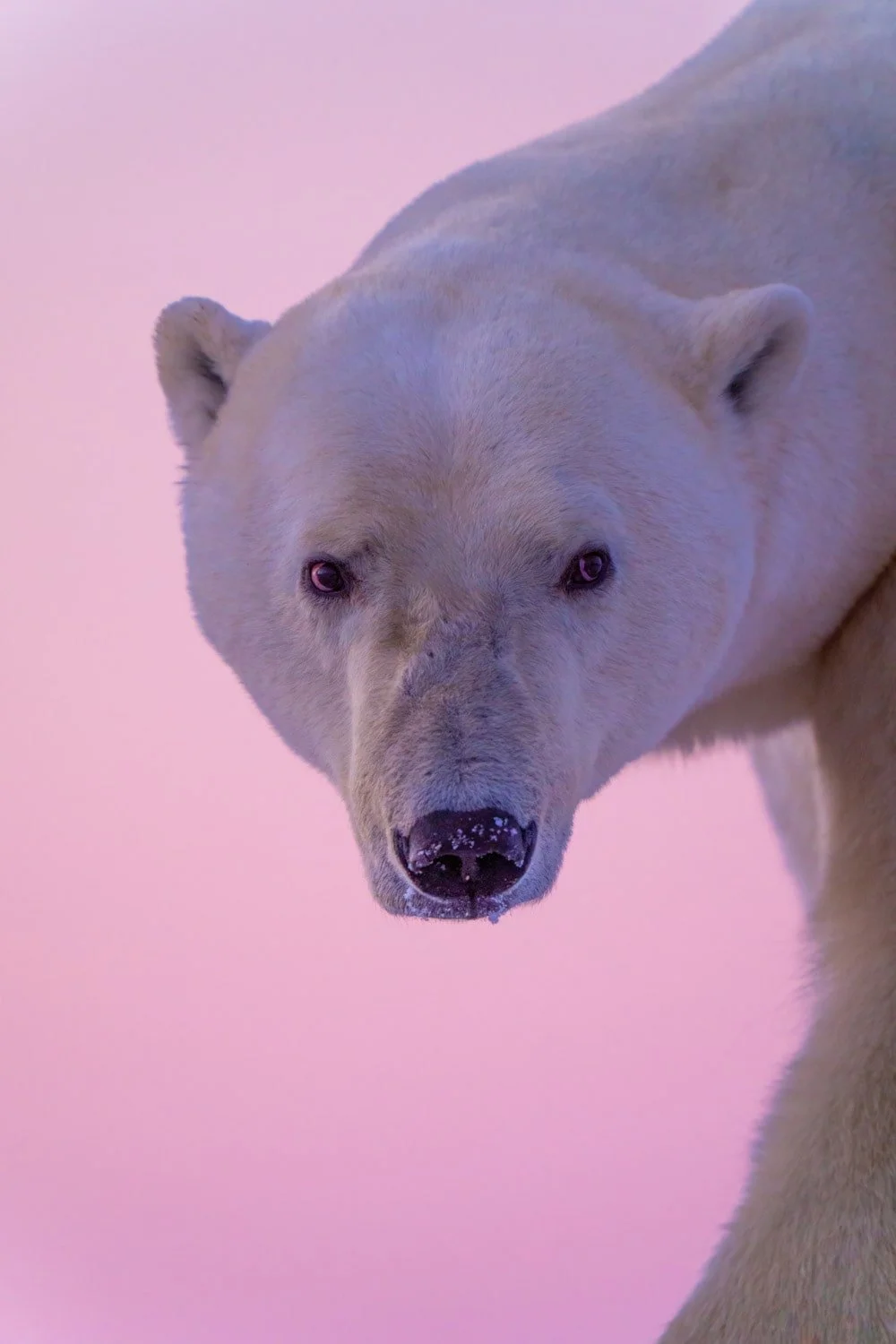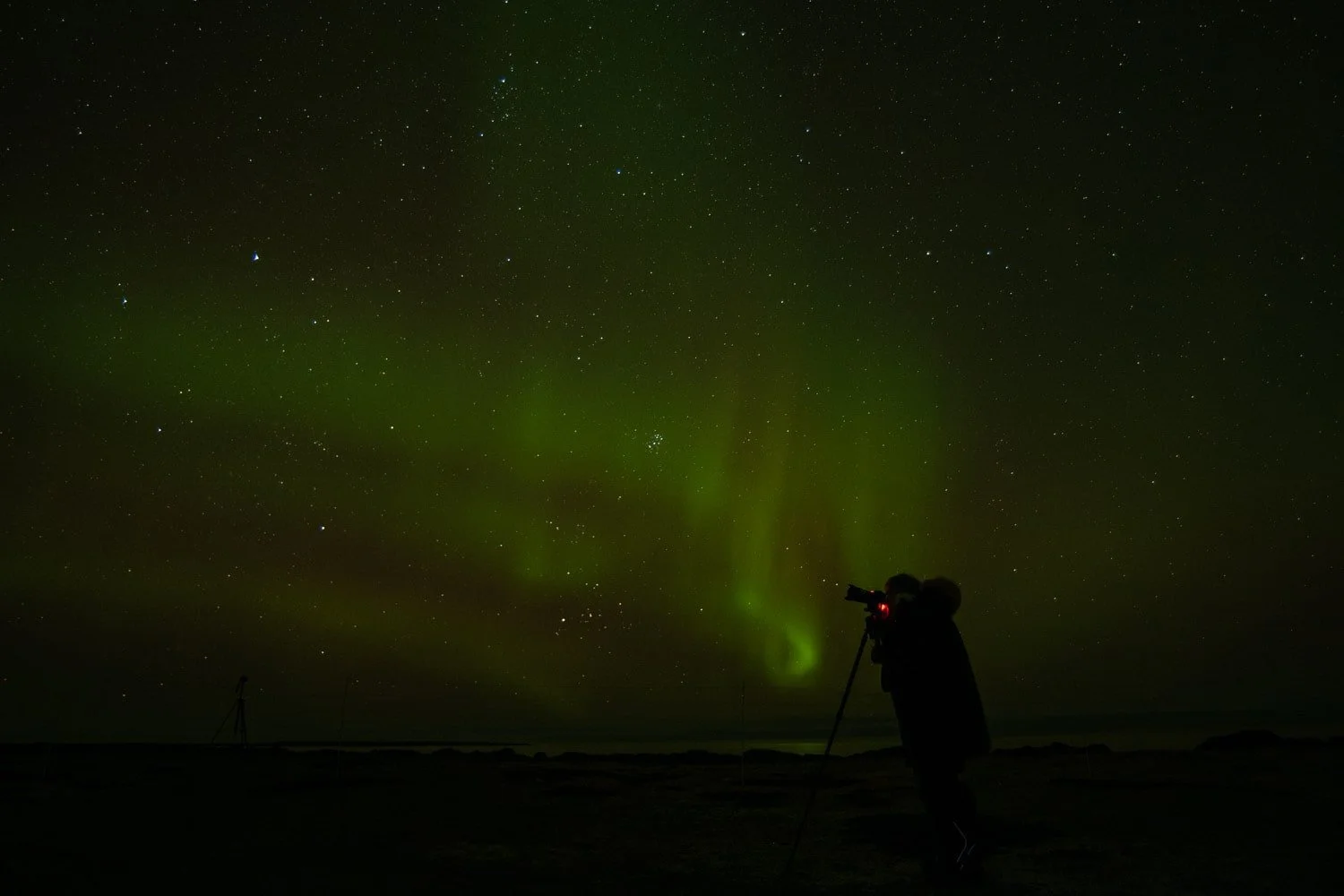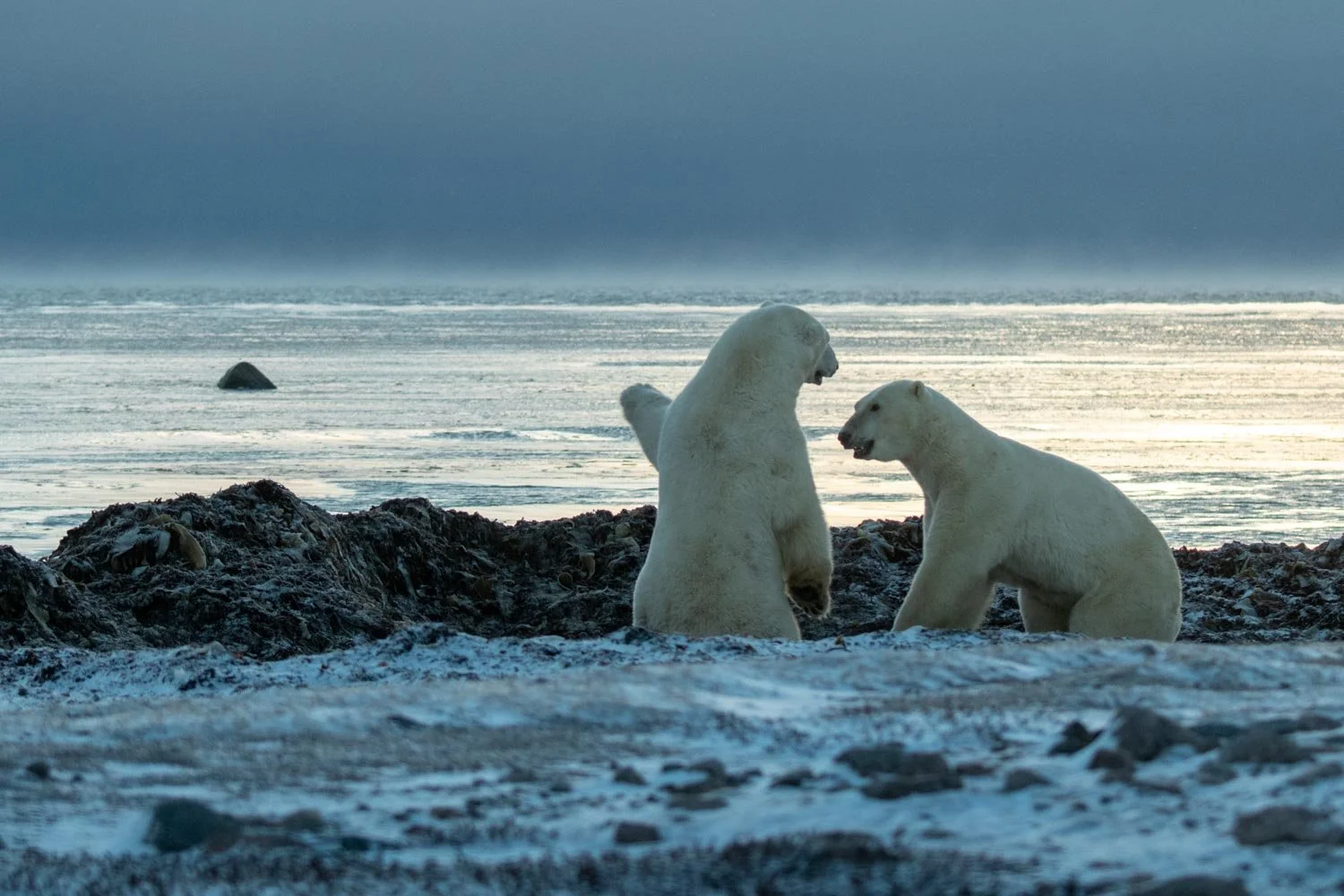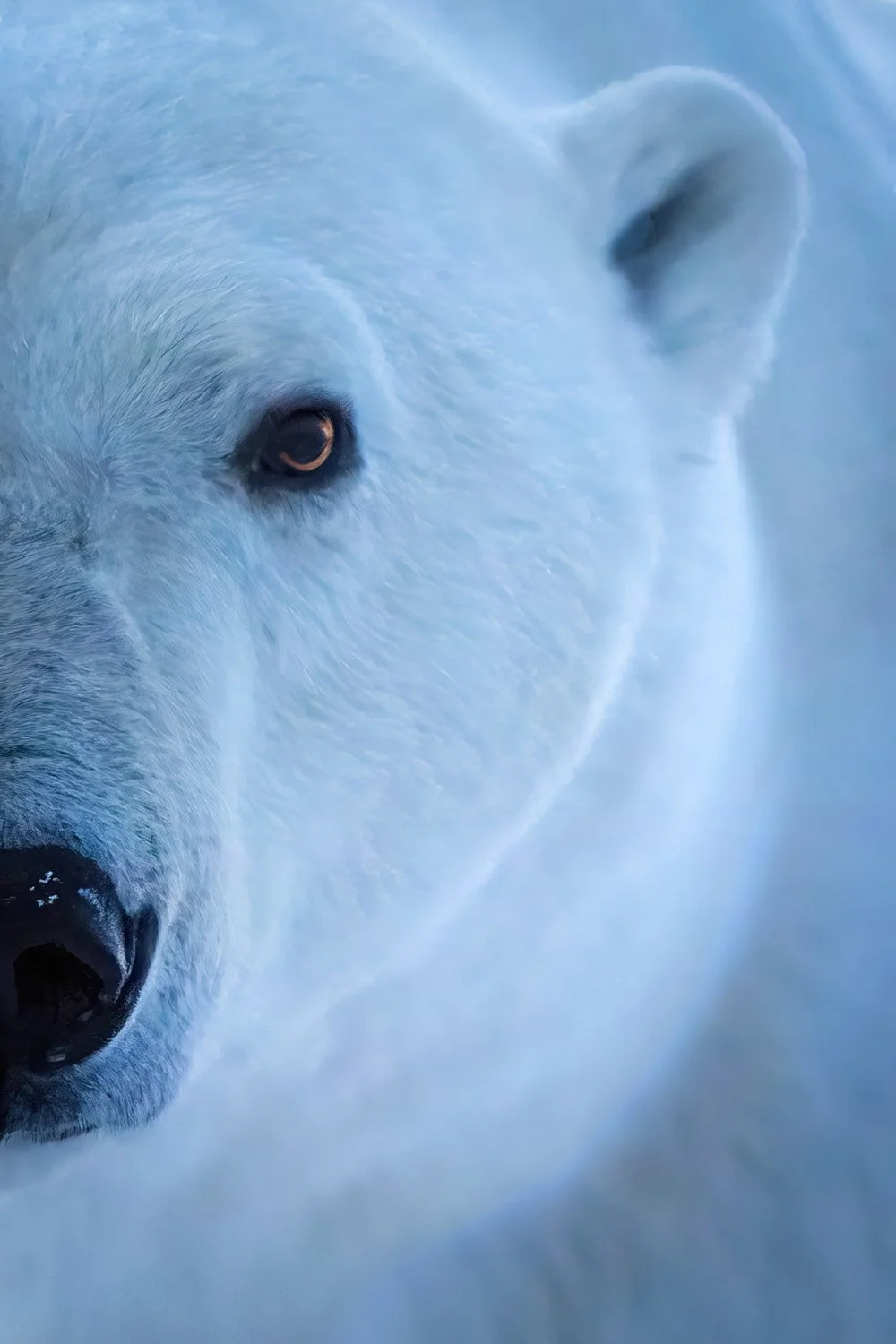Polar bear heaven
Where is Arviat, anyway…?!
Introduction
Imagine you were given a chance to spend £10,000 on an 11-day trip that only involved four days actually photographing polar bears. Would you take it?
I did.
I’ve just come back from Arviat in Nunavut, Canada, where I went with Andy Skillen and Arctic Kingdom to see the polar bear migration around Hudson Bay.
It was a pain to get there with all the Covid nonsense and flight schedule changes, but the payoff was that I saw plenty of polar bears, Arctic foxes and Arctic hares - and the northern lights were spectacular!
Head Down
Foxy Woxy
Purple Hare
Andy’s a very good tour leader with a good sense of humour, and the local staff were all very friendly and experienced, so they made sure we had fun and were well looked after.
I hadn’t been on a photography trip since going to Kicheche in January, and I was very rusty, so I didn’t take any great photos, but it was good to get back into the swing of things, and the whole Arviat experience was unique.
I’d seen polar bears before, but that was very different as it was on a cruise around Svalbard, and most of the bears were over 100 yards away.
In Arviat, we were able to see them at eye level from sometimes no more than 10 feet away!
The other benefit was that we went at a time of year that allowed us to see the sunrise and sunset, and that gave us the chance to use the gorgeous, pink and gold light to add something extra to our shots.
White as Snow
Planning
Arviat was definitely the most stressful trip I’ve ever had to plan, and Arctic Kingdom even sent us all a 20-minute video on how to cope with all the Covid regulations for entering Canada!
I booked the trip around three months in advance, and that didn’t help as I had even more time to worry about it.
The first problem was with my flights.
I never enjoy the travelling part of travel, and for this trip I had to take four flights: from London to Toronto, then on to Winnipeg, Churchill and Arviat.
I wanted to travel with one of the other guests to make the process a bit more bearable, and it turned out that I knew a guy called Russell from one of Andy’s trips to Brazil in 2016.
He wanted to arrive early to get over the jet lag and leave a couple of days later in case of any weather delay.
That was fine with me, and I synchronised my flights with his, but then Westjet changed their schedule, which meant I had to rebook everything.
It got worse when I was told that I couldn’t through-check my hold luggage all the way from London to Winnipeg via Toronto, and there wasn’t enough time between flights for me to go through security, pick up my bag and check back in again.
It didn’t help that the average wait time to speak to a British Airways agent was over an hour!
Eventually, I was told I could through-check my bag, but only if my flights were on the same booking reference!
I’d booked separately with BA and Westjet, so I had to cancel my Westjet booking and rebook the Toronto-Winnipeg flight with BA.
In the end, I got a much better price and managed to save around £500, but the whole experience was extremely stressful.
And that was before the whole Covid nightmare…
In the end, I was fortunate that the Government changed the rules on 4 October, so I didn’t have to take a PCR test while I was in Canada, but I still had to take one 72 hours before departure and another two days after I got back.
That meant I was left sweating on the result of the first test: if it wasn’t negative, I wouldn’t be able to go on the trip, and that would cost me the whole 10 grand!
When I eventually got to Heathrow, the BA agent immediately told me that I couldn’t through-check my bag after all…
You can imagine how I felt at that point, but all the travel arrangements turned out fine in the end…right up until I got back to London and found that BA had lost my rucksack!
Sigh…
Daily routine
Anyway, back to the story...
The hotel in Winnipeg was just across the road from the airport, but when I tried to check in, my booking had mysteriously vanished!
Fortunately, there was a sister hotel just next door, so I managed to get a room there.
I had a couple of days to kill, so I just read the paper and watched sport on my laptop before going for a drink in the hotel bar with Russell on the Saturday night.
Andy arrived the following afternoon, and we had a drink together in the lobby - which turned out to be on the house!
In the evening, he gave a briefing to all the guests in the hotel bar.
There were supposed to be seven people on the trip, but one couple unfortunately had to pull out due to illness, so in the end there were only five of us: Russell and I plus Alexandra, Barbie, and Patrick.
The following morning, we flew to Churchill and then Arviat.
Arriving at Churchill
Our plane on the airstrip at Arviat
The main cabin
We eventually arrived at the cabins at 1407 on Monday 8 November - three days and four hours after I’d left home!
We immediately had to take yet another Covid test, and then Russell and I were shown to cabin number two.
It wasn’t very big, there was no hot and cold running water, and the mattresses were so thin you could feel the wooden base of the bed underneath!
Our cabin
However, I don’t go on these trips for the accommodation, so it didn’t really bother me.
I do like my food, though, so we were lucky to have such a good chef in Patrick.
He managed a few minor miracles in very difficult circumstances, and I have fond memories of eating cheese toasties, snow goose and caribou!
"How would you like your caribou, sir?"
After lunch and a couple of briefings, we saw Arctic hares, a polar bear and an Arctic fox.
Sadly, it was too dark for most of it, and by the time the polar bear arrived I’d already left my cameras in the hallway of my cabin and taken the batteries out. Doh!
Fortunately, I was a bit more prepared for the northern lights a bit later.
I didn’t like the idea of having to get up in the middle of the night to see them, but it turned out that they arrived at around 2100, so that was much more convenient!
Andy gave us a briefing beforehand in order to give us the right camera settings to start off with, so we all got out our tripods, fitted our wide angle lenses and dialled in 1600 ISO, the widest possible aperture and a shutter speed of 25 seconds.
That did the trick for me, and I spent around an hour taking pictures of the cabins and the other photographers with green swirls of the aurora borealis in the background.
Aurora borealis with Barbie
You couldn’t see the colours with the naked eye, but they were clearly visible on camera, and the display the next night was even better - although I couldn’t be bothered to set up my Nikon DSLR all over again, so I just used my iPhone...
We also had regular sightings of polar bears, Arctic foxes and Arctic hares.
In total, we saw seven polar bears, including a mother and a cub twice and two male bears that spent half an hour ‘sparring’ about 50 yards away from us.
The sightings also usually lasted quite a while, and I had plenty of time to experiment with video, slow pans and what I call ‘sunny silhouettes’.
Even though the bears were all moving northwards to find the sea ice in order to start hunting for seals, the polar bears took their time.
As Andy explained, they live in a silent, barren world, so any distraction is interesting to them.
They also have a very good sense of smell, so they were usually well aware of us even before we could see them.
The bears did come pretty close, but the compound was surrounded by a seven-strand electric fence, and on the first night Dave and Jaime gave us a briefing about the escalating levels of deterrence they had at their disposal.
We all went outside, and Dave started out by showing how he’d shout at the bear if it got too close.
After that, he’d blow his whistle.
If it still kept on coming, Jaime would fire a 6mm charge from his rifle - which he did, and it was pretty loud!
After that came the 9mm charge - which was even louder.
Finally, Jaime fired a kind of ‘banger’ that whizzed out about 50 yards before exploding like a rocket.
The final sanction would obviously have been to shoot the bear, but nobody wanted to do that, and it’s actually illegal in Nunavut unless you find yourself in a truly life-threatening situation.
Fortunately, that never arrived on our trip, and even though the staff had to shout, blow their whistles and even fire one or two blanks, I never felt in danger.
Dave, Jaime, Peter and Kelvin knew what they were doing, which meant that the rest of us could focus on taking pictures.
Guard warns off polar bear with whistle and gun
During the rest of the week, we had polar bear sightings every day, so we generally took pictures from inside the compound.
I had a little three-legged aluminium stool, so I was happy to sit on that with the Sony camera on my tripod.
If there was nothing going on, we hung around outside or in the main cabin, where someone had chalked up a few local Inuit phrases on a blackboard.
Local knowledge
One afternoon, there were no bears in sight, so one or two people decided to make themselves a little more comfortable…!
Keeping cool in the sun
In the evenings, Jaime gave a few presentations on polar bears, their mating habits and his record-breaking trip around Svalbard by kayak.
We also went out for the occasional short walk to get a closer look at either the bears or the Arctic hares.
One day, we went on a longer hike to a place called The Willows, but it was a bit of a misnomer as the ‘trees’ were only about six inches high!
We didn’t see any wildlife apart from a couple of Arctic foxes in the distance, and we were getting pretty tired by the end of it.
Peter even drove out to us towing what looked like a wooden coffin behind him just in case anybody needed rescuing, but we ploughed on regardless.
"Are we nearly there yet...?"
In the end, we hiked for 3.3 miles, and all we had to show for it was this lousy photo!
Strike a pose...
Equipment
We were lucky to have so many wildlife sightings on the trip, but it was hard to make the most of them sometimes as my gear kept going wrong over the first couple of days.
I’d always been a Nikon man, but I recently bought a new Sony a1 mirrorless camera with a 400mm lens and 1.4x teleconverter, and I was keen to try it out.
Unfortunately, I wasn’t used to being able to take 30 frames per second, so I ended up filling up my only memory card just when the two male polar bears started play fighting!
I switched to my Nikon D850 with the 80-400mm lens, but the zoom froze up on me - literally!
I swapped the SD card from my Nikon to my Sony, but it was too late by then, so I had to make do with a few shots I took at 125mm rather than 400mm.
Very annoying.
There were also a few problems caused by the cold.
It wasn’t too bad when we first arrived: the sun was shining, there was hardly any snow on the ground and the temperature was quite mild.
However, the cabins were still very warm relative to the outside, and there was a real danger that our cameras would fog up and then freeze if we brought them inside and then took them out again.
As a result, Andy advised us to keep them in the hallways of our cabins - the small space in between the inner and outer doors that acted as a kind of ‘buffer zone’.
That caused particular problems for me as I didn’t have a card reader, so I had to download all my pictures while sitting on the porch with my cameras and laptop in sub-zero temperatures!
Sub-zero download
The other problem was how to keep our batteries charged.
Batteries run out very quickly in very cold weather, and it was hard to know what to do: if I took the batteries out and kept them in my pocket when I wasn’t shooting, then it would take valuable time to put them back in if there was a fresh sighting, but if I kept them in the cameras, then I’d run the risk of the batteries dying completely.
It wasn’t a problem with my Nikon D850 as I didn’t use it very much, but there was at least one occasion when both batteries died in my Sony!
That meant I had to rush back to the cabin and recharge them just at the moment when I was shooting a polar bear!
Fortunately, the effect of the warmer temperature inside meant it didn’t take very long, but I started keeping one of the Sony batteries in my pocket after that just in case.
As the temperature plummeted to -16° Centigrade during the week, my ‘shutter finger’ also started to get very cold, and I once had to switch to using my middle finger to keep going.
Eventually, I started putting my weatherproof cover on the Sony, and that killed two birds with one stone.
After that, my batteries lasted much longer, and I was no longer in danger of getting frostbite in my index finger…!
Epilogue
Overall, I enjoyed the trip, and we all had a lot of fun as a group, but the amount of travelling was a bit of a pain, and I just wasn’t use to the conditions, so it took me a while to ‘acclimatise’.
Once I’d sorted out the problems with my equipment, I was able to concentrate on simply taking pictures, and it was great to be able to get a few sunset shots.
I was also very pleased with my Sony a1.
I’d only had it for a week or so before the trip, so I’d barely had time to set it up and familiarise myself with all the controls, but it didn’t let me down.
It was a big (and expensive!) step moving from a Nikon DSLR to a Sony mirrorless camera, but I was very impressed with the accuracy of the autofocus system.
That was the main reason I’d bought it, and I look forward to being able to use it when tracking a cheetah running at full tilt!
I’m a big fan of sharpness in general, and the Sony a1 certainly lived up to my expectations.
I started out using the ‘Wide’ focus area, and that was pretty good when the background wasn’t too distracting, but I quickly learned that I’d also have to use one or two of the other options.
In the end, I tended to switch to ‘Zone’ or ‘Spot Medium’ if the camera was finding it hard to pick up the subject.
Given the cold conditions and the need to wear gloves, it wasn’t easy navigating the menu system (!), but I’ll hopefully be able to find a way to toggle between focus areas using one of the function buttons before I go on my next trip.
All in all, I was very happy with my visit to Arviat, and I’m grateful to both the staff and the guests for making it so enjoyable.
Roll on, Antarctica…!
Species list
Mammals
Arctic fox
Arctic hare
Polar bear
Ringed seal
Birds
Crow
King eider duck
Red-throated merganser
Snow bunting
Snowy owl
Butcher’s bill
1 x rucksack (lost by British Airways/WestJet) containing the following items:
1 x Manfrotto tripod with Benro gimbal head
1 x Manfrotto monopod
1 x Canada Goose Arctic rigger coverall
1 x tracksuit bottom
1 x toiletries bag, containing electric toothbrush and charger, toothpaste, razor, shaving oil, deodorant
1 x pair of Paul Smith deck shoes
3 x pairs of jersey boxers
3 x pairs of thermal socks
1 x pair of black socks
1 x three-legged aluminium stool
If you’d like to order a framed print of one of my wildlife photographs, please visit the Prints page.
If you’d like to book a lesson or order an online photography course, please visit my Lessons and Courses pages.









